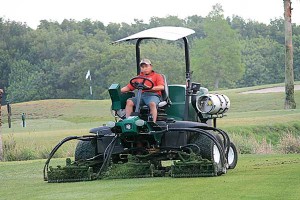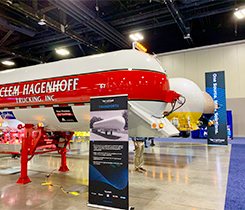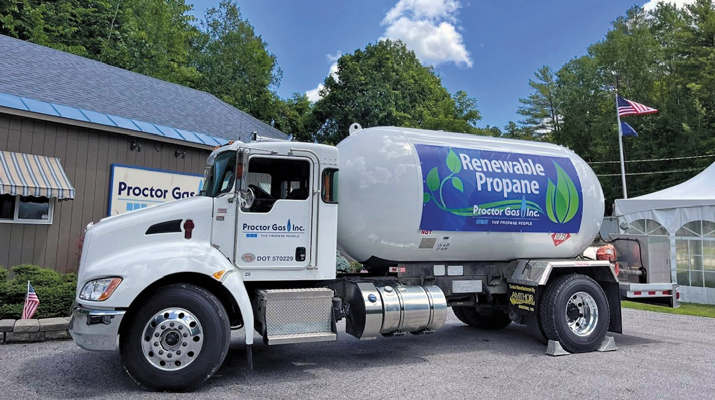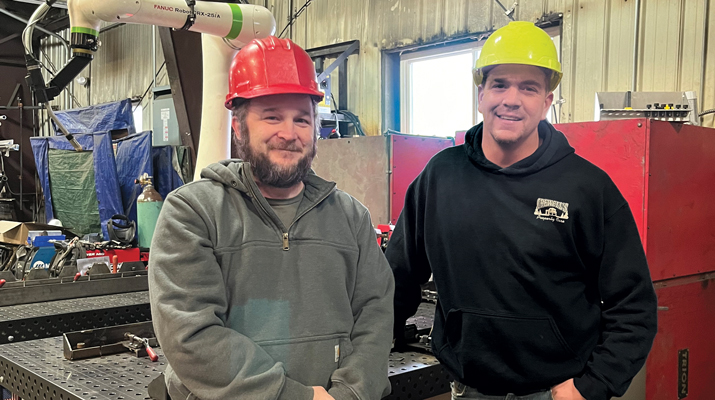Study highlights use of propane-powered turf equipment
Scott Corwin wasn’t about to say no to free turf equipment.
Corwin, the golf course superintendent at the Vinoy Renaissance St. Petersburg Resort & Golf Club in St. Petersburg, Fla., had the opportunity to trial four pieces of propane-powered equipment as a participant in a yearlong Propane Education & Research Council (PERC) program, hosted in partnership with Audubon International and R&R Products Inc. The Vinoy received three R&R Products mowers and a bunker rake from the company through the program, which included nine participating golf courses across the United States.
“You always have to look out for your company, and my No. 1 priority is to take care of the Vinoy,” Corwin says. “My job is to make sure we are doing the right thing for the company and the golf course.”
Because Corwin is approaching retirement, he originally had the thought that participating in the program and introducing alternative fuel equipment to the Vinoy would be a nice lasting mark on his legacy at the property. But as Corwin’s experience with the propane-powered equipment grew, he realized the equipment’s benefits stretch beyond the greener image the Vinoy can now promote.
According to PERC, which gathered data from participating courses, the Vinoy achieved 45 percent fuel savings over diesel with the fairway mower and trim mower it used in the demonstration. In addition, the Vinoy experienced 25 percent fuel savings over gasoline with the greens mower and bunker rake.
The Vinoy, however, isn’t the only course to report significant fuel savings to PERC. Between the nine participating courses, fuel savings of between 20 and 50 percent were reported compared with competitive diesel- and gasoline-powered models.
The average gallon-per-hour use of the propane equipment positions propane competitively, as well. According to PERC, the fuel consumption of the propane-powered greens mower and bunker rake was on par with gasoline. The propane-powered fairway mower and trim mower were slightly less efficient than their diesel counterparts, but propane still has a winning argument when considering the prices of the two fuels.
“The [golf course] market is in its infancy and sending four pieces of equipment [out] doesn’t sound like a whole lot, but the momentum is starting to swing heavily toward propane,” says Jeremy Wishart, the deputy director of business development for PERC, who has worked closely with the research program.
A winning argument

Says R&R Products’ Jim Coker: “The quality of some golf courses is really based on the mechanic.” Photos courtesy of PERC.
Fuel savings are just one benefit participating golf courses experienced putting propane equipment to use through the program.
The benefits of the equipment went beyond cost savings, though. For example, the propane mowers utilized reduced emissions compared with diesel units, according to PERC and program participants.
As an example, based on data collected through May 15, PERC reports participating courses reduced their greenhouse gas emissions by 15 percent and carbon monoxide emissions by 50 percent. The equipment’s potential environmental benefits, touted ahead of the program’s launch, were one aspect that attracted David H. Robinson, senior director of golf grounds at Marriott Golf.
“We’re constantly looking at new ways we can improve our golf course operations,” Robinson says. “We look at the carbon footprint at all our properties. We’ve done the calculations, so this was a great next step to enable us to reduce our carbon footprint even more.”
Three Marriott Golf courses participated in the program, including the Marriott Desert Springs Golf Club in Palm Desert, Calif.; Stone Mountain Golf Club in Stone Mountain, Ga.; and the Vinoy.
“We had some great results at all three,” Robinson says. “They were all a little different. Everybody had different opinions of the equipment and their operation, but for the most part it was all really positive.”
For Robinson, the environmental benefits achieved switching from diesel and gasoline to propane are even more rewarding than the cost savings the participating Marriott courses achieved.
“Yes, the savings and dollar amounts are great, but when we approach these different environmental programs and initiatives that’s not the first thing we look at,” he says. “The first thing is the impact to the environment and associates, employees, members and guests and, ultimately, what it does long term in a positive way for the golf course. I think it’s fitting perfectly right now for us.
“We’re certainly not at the point where we are going to replace all of our equipment globally with propane,” Robinson adds. “But I think over the next couple of years we are really going to take a closer look at it. We have some pretty lofty goals here, getting almost everything that can be converted to propane [to propane]. There probably aren’t too many courses around doing that.”
Out to change history

A grounds crew employee operates a propane-powered Reel Max 544LP five-gang fairway mower at the Vinoy Renaissance St. Petersburg Resort & Golf Club in St. Petersburg, Fla. The Vinoy trialed four pieces of propane-powered equipment in the program, giving the 544LP mower a 10-point overall rating out of 10, as well as a 10-point score on maintenance. Photo by Grant Gannon
The propane industry and its potential customers must hear remarks like Robinson’s for it to gain traction in a market that has largely resisted propane to date.
According to Wishart, the historical claim among turf equipment manufacturers is that propane has no place in the golf course market. There’s simply no demand for it, opponents argue.
But the market has expressed some interest of late in developing environmental and sustainability programs. So PERC seized the opportunity to collaborate with Audubon International, a not-for-profit environmental organization dedicated to providing people with the education needed to practice responsible management of land, water, wildlife and other natural resources.
“The reason we partnered with Audubon International from the start was because we wanted to partner with courses and organizations that were willing to take that next step and take a little bit of risk,” Wishart says. “We purposely chose the courses because they were already well-engaged in environmental programs. They were known for stepping out on a limb on their own.
“At the same time, we knew those guys would not be afraid to tell us if an area of our product or service was lacking.”
Propane delivery service is not lacking for the Vinoy, which receives fuel locally from Suburban Propane.
“Suburban comes every Monday and fills us up,” Corwin says. “We’ve never run out, and I can’t say that with gasoline or diesel.”
In terms of maintenance, the Vinoy rates its propane equipment with 9s and 10s out of 10. Most participating courses rate the R&R Products equipment favorably in terms of maintenance, as only one course, the Fernandina Beach Golf Club in Fernandina Beach, Fla., gave a maintenance rating of less than 7 out of 10 to a piece of equipment.
Propane offers a number of advantages from an equipment maintenance standpoint, Corwin says – particularly over diesel.
“We’re at Tier 4 [diesel technology] right now, but pretty soon it’ll be Tier 5,” he says. “What’s that going to do for your equipment maintenance budget? Mechanics aren’t going to be able to work on them without computers. So now they are going to send [equipment] to get worked on. And it’s $100 an hour now to send a mower to get worked on that you can work on in your own shop.”
The quality of golf courses is sometimes dependent on their mechanics’ abilities, adds Jim Coker, director of propane applications at R&R Products.
“I see a lot of these guys are struggling with budgets,” he says.
Building more momentum
Although the turf equipment research program offers a number of positive takeaways for propane, work remains to make propane a truly viable fuel in the golf course market.
“To make the market grow to the level that we want, we need at least another manufacturer,” Wishart says. “Whether that’s John Deere or Toro or another R&R, however it works out, it legitimizes what we’re trying to do.”
One positive sign for propane is that four of the golf courses participating in the program already purchased their demo equipment. Plus, another two courses are in the process of purchasing their equipment, PERC reports.
Although one intent of the program is to show golf course superintendents the capabilities of propane, PERC also seeks to show equipment manufacturers and propane marketers the potential of the fuel in the market.
“We’re building interest and awareness,” Wishart says. “Once we get course managers and superintendents asking for it, you’ll see other OEM brands coming on. They’re watching this really closely.”
Once propane is established as a fixture for turf equipment, Wishart envisions the fuel translating to other areas of golf properties.
“A next step in the process of building out a marketing campaign is heating, cooking and outdoor patio heating,” he says. “It’s showing them everything propane can do as a fuel.”
Participating golf courses
Golf courses participating in the propane equipment research and demonstration program with the Propane Education & Research Council, Audubon International and R&R Products Inc. are:
- Chick Evans Golf Course, Morton Grove, Ill.
- Columbus Municipal Golf Courses, Columbus, Ohio
- Eagles Pride Golf Course, Tacoma, Wash.
- Fernandina Beach Golf Club, Fernandina Beach, Fla.
- George Dunne Golf Course, Oak Forest, Ill.
- Marriott Desert Springs Golf Club, Palm Desert, Calif.
- Reston National Golf Course, Reston, Va.
- Stone Mountain Golf Club, Stone Mountain, Ga.
- The Vinoy Renaissance St. Petersburg Resort & Golf Club, St. Petersburg, Fla.
About the demoed equipment
Of the nine U.S. golf courses participating in the research and demonstration program starting in October 2014, seven provided data on four pieces of equipment available from R&R Products Inc. Courses trialed the Reel Max 331LP finish-cut trim mower, the Reel Max 544LP and 744LP five-gang fairway mowers, the Greens Max 2200LP riding greens mower and the Sand Max 521LP bunker rake.
Extra: How golf course superintendents rate their propane-powered demo equipment
Grant Gannon, associate editor of Golfdom magazine, a sister publication to LP Gas, contributed to this article.
















